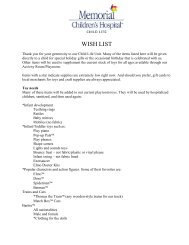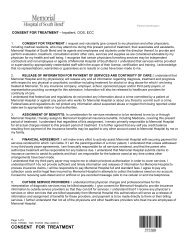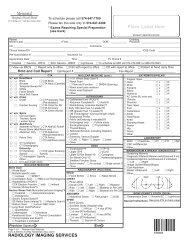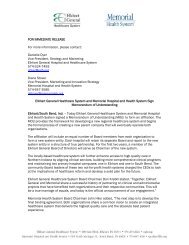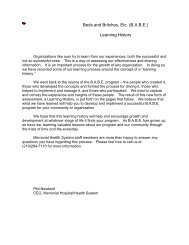Spring 2008 - Memorial Hospital of South Bend
Spring 2008 - Memorial Hospital of South Bend
Spring 2008 - Memorial Hospital of South Bend
You also want an ePaper? Increase the reach of your titles
YUMPU automatically turns print PDFs into web optimized ePapers that Google loves.
Read<br />
theLabel<br />
Back in 1990, the Nutrition Labeling and Education Act launched the modern food label. The federal<br />
government wanted to improve food labels so that consumers could make healthier food choices. The<br />
new labels were introduced in 1994.<br />
And now, 10-plus years later, many people still don’t know what they mean. That’s too bad, because<br />
there is a lot <strong>of</strong> important and helpful information on food labels. Here’s what to look for.<br />
PULSE › <strong>Memorial</strong> Health System › 574-647-6800<br />
SERVING SIZE<br />
All the information on a label is<br />
per serving. Be sure to compare<br />
the serving size with the amount<br />
you are eating. If a package has<br />
two servings in it and you eat the<br />
whole thing, you are getting twice<br />
the calories, fat and sodium listed<br />
on a per-serving basis.<br />
CALORIES<br />
How many daily calories you need<br />
depends on your weight and<br />
activity level. The range is usually<br />
2,000 to 2,500 per day. If you are<br />
trying to lose weight, <strong>of</strong> course,<br />
you want fewer calories.<br />
CALORIES FROM FAT<br />
Your goal is for no more than<br />
30 percent <strong>of</strong> your calories to<br />
come from fat. More than that is<br />
bad news for your heart.<br />
TOTAL FAT/SATURATED FAT<br />
Not all fats are created equal.<br />
Saturated fats are the bad kind.<br />
They raise cholesterol and the risk<br />
<strong>of</strong> heart disease. Keep total fat<br />
low, and saturated fat even lower.<br />
CHOLESTEROL<br />
Too much cholesterol can lead to<br />
heart disease. Try to keep total<br />
daily cholesterol to less than<br />
200 milligrams (mg) a day, lower<br />
still if your doctor recommends it.<br />
SODIUM<br />
Too much sodium increases blood<br />
pressure, so watch out. Processed<br />
foods are loaded with sodium.<br />
TOTAL CARBOHYDRATE<br />
The Atkins diet has many people<br />
focusing here. Don’t. You need<br />
carbohydrates and the fiber they<br />
contain for energy and for disease<br />
prevention. Twenty to 35 grams <strong>of</strong><br />
fiber a day is recommended.<br />
SUGARS<br />
Sugar is a type <strong>of</strong> carbohydrate. So<br />
total carbs is the more important<br />
number. However, watch for added<br />
sugars in processed foods, soda<br />
and sweets. They add “empty”<br />
calories that have no nutritional<br />
value but pile on the pounds.<br />
PROTEIN<br />
Americans are big meat- and<br />
milk-consumers, so we usually<br />
get more protein than we actually<br />
need. Try to limit animal-based<br />
proteins, which are high in fat and<br />
cholesterol. Instead, buy low-fat<br />
milk products and add protein<br />
from beans, grains and cereals.<br />
VITAMINS AND MINERALS<br />
The goal is to reach 100 percent<br />
<strong>of</strong> each, every day. Food is the<br />
best source <strong>of</strong> these nutrients,<br />
but many people need a daily<br />
multivitamin to help.<br />
018





